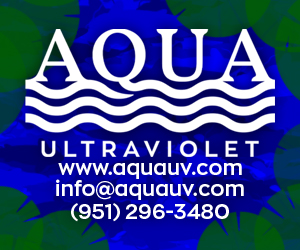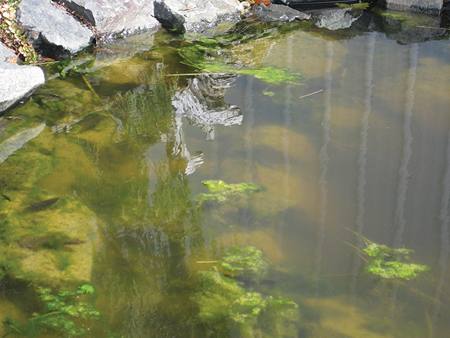
We receive thousands of phone calls each year, and a significant number of them are from pond owners and pond-service companies who are struggling to keep a pond clear and beautiful. This is so sad, because they are being robbed of the joys of living the pond life, especially considering that keeping a pond in proper ecological balance is really a very simple process.
I know it is hard to believe, but there are parts of the country where it has been common practice to ignore the need for filtration. Or, if they do use filtration, there is a lack of understanding of the importance of properly-sized filtration. Then there are those who aren’t aware that there is an underlying design problem, and after using every recommended treatment out there, they still battle to keep their pond clear. This is not good for the pond owner or the future of the water-feature industry.
Keep It Simple…
I know there are very good, detailed diagnostic lists of varying sizes out there. But I would suggest that simply utilizing the K.I.S.S. principle first will provide significant benefits in most cases.
1. Quickly review the current pond design. Are all best practices in place?
2. Provide an easy-to-understand (and easy-to-remember) diagnosis and action steps for the customer.
3. Call back and measure the results.
By applying the K.I.S.S. (Keep It Simple Stupid) principle, we have found that a quick and basic Diagnostic Punch List can quickly diagnose the issues contributing to the ongoing problem — which usually include cloudy water or algae. At the same time, this list provides the customer with corrective steps that are easy to understand and follow, along with immediate and long-term solutions.
In most cases, there are between one and four contributing factors. First, the pond owner may not be knowledgeable of the basic principles of ecological pond balance and the simple steps of pond maintenance. Second, the pond may not have been properly installed in the first place because the installer did not apply best practices. Third, the demands on the pond’s filtration system may have outgrown the original design. Finally, there could be a lack of understanding about what natural influences Mother Nature has on a body of water, especially in early spring.
As a result, pond owners and way too many installers simply rely on a pond treatment to solve the problem. Natural pond treatments are certainly part of the program, and problem-solver pond treatments might be the right thing to implement to help a pond get back in balance. However, way too many times, these are used to treat the symptoms instead of correcting an underlying persistent problem.
Ecological Balance
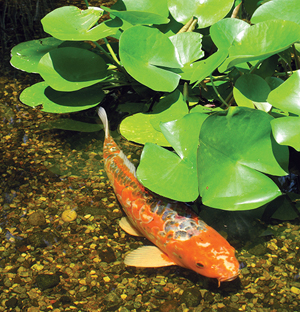
In the spring, pond water goes through a natural balancing process. Algae and beneficial bacteria feed on the same nutrients in the water column. However, single-cell algae and string algae are active, while beneficial bacteria are slow to become fully active until the water temperature surpasses 45 degrees Fahrenheit. (Bacteria really get going in the 50s.) So, algae are at the banquet table without a lot of competition. In a perfect spring, when temperatures rise and hold, this process will take two weeks. It’s always a good idea to get the filtration system up and running and introduce beneficial bacteria sooner than later. It is OK to perform a 25-percent water change in the spring as part of the cleaning process, but do not perform repeated water changes just because the water is pea-green. This just starts the process all over again. During the first month of the spring, as the pond is seeking balance and cleaning itself, clean out the filter pads weekly. Always clean the pads shortly after using an algaecide or water clarifier. If they are full, they will no longer assist in removing the algae and free-floating particles from the water column. You won’t need to do this as frequently during the season, but this simple practice will have significant benefits.
Summer’s warmer water does not hold as much oxygen, and oxygen is extremely important for beneficial bacteria to perform properly. You may want to turn on the aeration system during the heat of the summer. Pond plants should cover 25 to 33 percent of the pond to aid in nutrient uptake and to restrict sunlight from aiding in algae growth. They also keep the water cooler for improved oxygen levels.
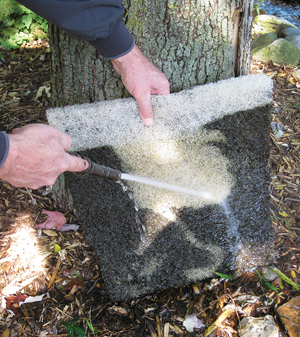
Tannins may impact the pond during spring and fall. All plant leaves have tannins, and in the spring when leaves bud out, they drop their scales, which are full of tannins. Spring maple seeds and leaves in the fall will also release tannins in the pond. This can cause the pond to take on a coloration ranging from a tea-brown to even black. The best practice is to use a leaf or pond net to remove the leaves. Although tannins will not harm the fish, performing a 25-percent water change will certainly aid in clearing up the water.
Achieving and maintaining healthy, ecologically balanced, “gin-clear” water relies on the teamwork of oxygen-rich water, proper timing and the application of natural-water treatments and proper filtration basics.
Diagnostic Punch List
First, are we on a proper water treatment program? The scheduled use and application of pond treatments is the first thing to always review. All natural beneficial bacteria should be applied on a regular schedule to reduce ammonia, nitrite and phosphates. To insure a high count of beneficial bacteria, especially in the first month of spring, apply all-season pond bacteria weekly. For the rest of the season, follow the instructions on the bottle. Remember, high levels of nitrates and phosphates contribute to algae blooms. Fish food not eaten within five minutes decays and increases the phosphates in the water, which can contribute to algae. If there is a UV filter in use, turn it off for 24 hours to allow the beneficial bacteria to settle out of the water column and find a new home on the surface area, on the rocks or in the biofiltration system.
Water conditioner needs to be applied every time we add water to the pond. This removes chlorine, destroys chloramines and detoxifies heavy metals. Even if the water source is a well, there are still heavy metals present. So, yes water conditioner is still a must.
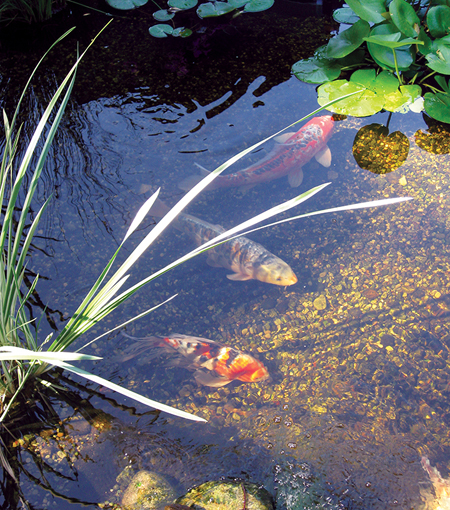
Next, does the pond have sufficient filtration? So many people think they have something they don’t. Proper filtration flows! The general rules are: if you do not have fish, you will need to filter the water volume once every two hours. If you have fish, you will need to filter the water volume once every hour. And in my koi pond, I personally filter the water volume every 20 to 30 minutes, because koi need clean, healthy water, and they produce 1,000 times more waste than other varieties of fish. They are eating machines!
Let’s say we have a 3,000-gallon pond with fish, and we want to filter the water volume once an hour. We will need a pump, filter and plumbing that can handle 50 gallons per minute after lift. Simple, right? Well, here are some areas where a pond can become ecologically unbalanced.
1. Perhaps the fish load has outgrown the original design and continues to overpower the filtration system. Originally, let’s say the pond had a few small, 4-to-6-inch koi, and now they’re each more than 18 inches. The answer is to increase the filtration or reduce the fish load. A rule of thumb is to allow 500 gallons per grown koi. If there is excellent filtration, you may get closer to 250 gallons per koi.
2. Is the pump the correct size to produce 50 gallons per minute after lift? Static lift is measured from the top of the water surface to the top of the waterfall or biofilter. It is the reduction in water flow from gravity when lifting water. If the pump is not producing the required 50 gallons per minute after lift, the rate required for proper filtration has been reduced.
3. If the pond has a pressurized filter, it could be undersized. Here’s how it happens. Pressurized filters are marketed with the statement “for ponds up to X gallons.” This sizing is based on a pond with no fish, or a filtration flow of once every two hours. To select the properly sized pressurized filter, match the required filtration rate to the filter’s maximum rate of flow.
4. Finally, a pond can often have the right-sized pump and still have a significantly reduced rate of flow. How does this happen? Flow rate can be restricted with tubing that is too small. Just because a pump has a 2-inch outlet does not necessarily mean 2-inch tubing is enough. Know the maximum recommend gallon-per-minute flow rates for flex PVC pipe:
• 1 inch = 25 gpm (1,500gph)
• 1 ½ inches = 60 gpm (3,600 gph)
• 2 inches = 90 gpm (5,400 gph)
• 3 inches = 225 gpm (13,500 gph)
To round out the Diagnostic Punch List, make sure the pond has enough of the right types of plants. Plants play an extremely important role in the ecological balance of a pond. They up take nutrients and help keep the water cooler in the summer, shading the water from the sun. Water hyacinth and water lettuce perform this task well, and their long root systems are fantastic at cleaning. There should be a balance of bog, submerged and floating plant life.
From the Medicine Cabinet
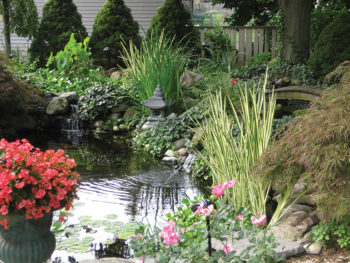
Algaecides and water clarifiers are only necessary when a pond needs assistance getting back into a natural balance. Water clarifier is a formula that clears murky water quickly. It attracts and congregates suspended particles, allowing them to settle out of the water column for removal by the filtration system. Use only treatments designed for backyard ponds with fish. And when using these products, make sure the pond has oxygen-rich water from waterfalls or bottom-diffused aeration.
I have often thought that it would be so beneficial if all installers provided new, proud pond owners with written information outlining the basics on maintaining the ecological balance, what to expect from Mother Nature, a guide to pond treatments and the importance of pond plants and proper filtration. These concepts might seem basic to some of us, but just being aware of them can make a world of difference for all pond owners.
